Levator scapular muscle stretching exercise
Table of Contents
What is the levator scapulae stretch?
- Levator scapular stretch is required when the neck muscles mainly the Levator scapular, as well as upper trapezius muscles, become tight & neck motion is difficult. It leads to pain in the neck to shoulder region.
- Levator scapulae are the dorsal Axio-appendicular muscle. This joins the upper limb to the vertebral column & is located in the dorsal triangle of the neck. The superior part of the levator scapulae is protected by the sternocleidomastoid & its lower part by the trapezius.
- The levator scapulae work to elevate the scapula & tilting the glenoid cavity inferiorly by rotating the shoulder blade downward. If the scapula was fixed, a levator scapulae contraction leads to the side flexion of the cervical spine as well as stabilizes the vertebral column while moving.
- There are many techniques to stretch the levator scapulae muscle. This has some benefits which assist in our daily life to do routine chores.
What are the benefits of levator scapulae stretching?
There are some common benefits of the levator scapulae stretching are below:
- Gently stretching decreases tightness or soreness in the muscle.
- Helps in relieving Levator scapular muscle pain.
- Daily stretching of the muscle can lower the risk of neck pain returning. This relieves neck pain.
- Prevention of forwarding head posture & improvement posture.
- Increase blood flow around the neck.
- Relax the neck joint.
- Increases the neck range of movement.
- This lengthens the levator scapulae muscle, to perform its full motion.
What are the types of levator scapulae stretching?
There are various techniques to perform levator scapulae stretching, those are below:
Levator scapulae stretching in a sitting position
- How to do this stretching exercise: Sit straight on the chair.
- Grasp the end of the seat with the left hand to lower the left shoulder by pulling towards the ground.
- Tilt & turn the head to the right side.
- Then do the slightly forward nod of the head until you felt the stretch to the left side & back of the neck.
- Apply gentle pressure with the right hand to increase the stretch.
- Hold the stretch for 30 seconds & relax. Do this stretching exercise 2-3 times on each side.
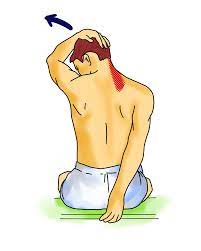
Levator scapulae stretching in a sitting position on the bench
- How to do this stretching exercise: Take the Sitting position on the bench on the side edge, hold the bottom of the bench with the right hand, assuring that the right arm is away from the body & that the shoulder is down.
- Now do the forward flexion of the head towards the chest.
- Then, do the side bending & rotation of the neck as well as bring the chin towards the left armpit.
- Bring the left hand up onto the side of the head to help the stretch.
- Return to the starting position & repeat.
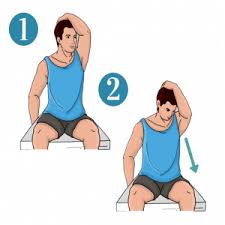
Levator scapulae stretching in a standing position
- How to do this stretching exercise:
- Stand straight. Now, place the right hand behind the buttock to down the shoulder.
- Turn the head to the left side & look towards the ground.
- Slowly pull down on the head with the left hand & maintain the position until the patient feels the stretching sensation.
- Repeat this stretch on the left side.

Levator scapulae stretching in sitting or standing
- How to do this stretching exercise:
- The patient may perform this stretching sitting or even standing position.
- Keeping the left shoulder downward that you are stretching, look toward the floor & to the right hip.
- When the patient feels comfortable stretch, hold this position for 20 seconds & relax.
- Also, the patient can sit on the left hand to pull the shoulder downward even more.
- Use the right arm to pull the head towards the ground into a deeper stretch.
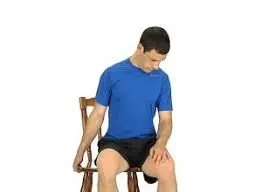
Some variations of the stretching of the levator scapulae muscle
Levator scapulae stretching with a band
How to do the stretching exercise:
- Step on the strong band on the left side this is the stretching side.
- Grasp the band with the left hand, allowing the band to anchor the right arm & shoulder down.
- Side-bend the head toward the right shoulder of the anchoring side. Next, tuck the chin in toward the right side to watch at the front pocket.
- The patient can feel a comfortable stretch on the left side of the neck & above the scapula on the same side as the band.
- Hold this position & repeat the exercise on the right side by stepping on the band with the left foot.
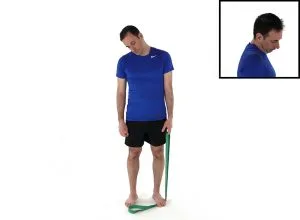
Levator scapulae stretching by the physical therapist
How to do this stretching exercise
- In this stretch, the patient can use assistance to do the stretch.
- Take the sitting position on the chair. The back should be straight.
- Now the assistant put his hand on the head on the side of the stretching.
- And turn the head on the opposite side & look towards the opposite side.
- Now the assistance gives extra pressure to feel a stretch.
- Hold this for 20 seconds and repeat.

How to do this stretching exercise
- Take the standing position. Now raise the hand as well as the elbow & place it on the wall or door jamb, rather than grasping the back of the shoulder.
- The elbow is held above the shoulder level & the shoulder cannot shrug upward.
- Side bend the neck to the opposite side & tuck the chin inward as well as look to the opposite leg.
- The patient can feel stretch & hold that position and repeat.

Levator scapulae stretching with the affected side’s hand behind the back
How to do this stretching exercise
- Raise the left arm forwards & reach over the back with the hand grasping the left scapula and applying downward pressure. The step rotates the scapula downward, which lengthens the muscle before you feel stretched.
- Now turn & bend the head right side, and look downward.
- When the patient feels stretched, hold that position & repeat. Now do it on another side.
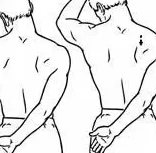
Common mistakes are done while the Levator scapular stretch is performing
There are some common mistakes the patient may make during stretching:
- Avoid taking the straight sitting position, which makes the stretch wrong.
- The patient may compress the neck instead of forwarding & downward bending the head.
- The patient may rotate the head excessively or not enough.
- The movement does not accompany the direction of the nose straight toward the knee.
Some things the patient does not perform while Levator scapular stretch
There are certain matters you should keep in the mind during stretching:
- Do not give extra pressure while a stretch which may injure the other structure of the neck.
- Do not perform stretching, when the patient has a chronic illness.
- The patient does not need to do stretching in pain or even sprain muscles.
- If the patient has a fracture around the neck joint, then you should not do stretching.
- If the patient feels pain while stretching, then stop right there and do not complete the stretch.
- The patient should follow the instructions of the physical therapist.
FAQ
What causes tight levator scapulae?
Sitting for prolonged periods, especially with bad posture, is the most common cause of levator scapulae syndrome. The different muscles in the neck and the back, particularly the levator scapulae muscle, are stressed & irritated by sitting for long periods with bad posture.
How does the patient know if your levator scapulae are tight?
Commonly the definitive clinical feature associated with Lev Scap tightness is an inability or unwillingness to move the head/neck into rotation. Usually, flexion & extension are pain-free. Only in chronic cases of Lev Scap tightness will full shoulder abduction be limited.
What does the torn levator scapulae feel like?
Neck pain, which may extend to the head causing the headache. Pain & restricted range of movement especially decreased cervical flexion & side flexion to the contralateral side. Deep, achy pain and/or tightness on the upper back along the top of the shoulder blade or neck.
Why does the levator hurt?
Levator scapulae syndrome is usually caused by the poor posture of the shoulders. For instance, sitting at the computer hunched over with the shoulders rounded. This posture stretches the levator scapulae muscle & if performed over a long period of time, this can cause inflammation & pain within the muscle.
Can levator scapulae pinch a nerve?
If the patient often sits in front of her desk and looks at her phone or screen while tilting her head downwards, you will most likely have levator scapulae pinched nerve. This behavior may cause the gradual shifting of the neck bone positions. Unfortunately, when the bones shift, the nerves can get compressed or irritated.

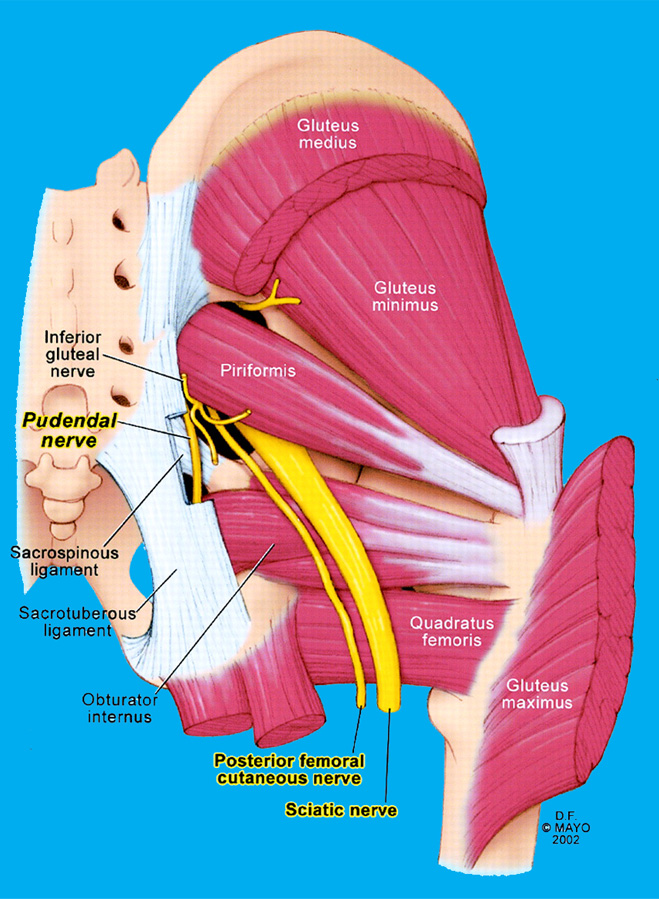
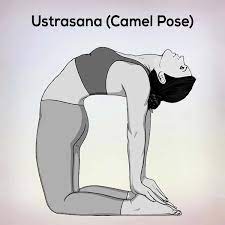
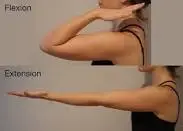
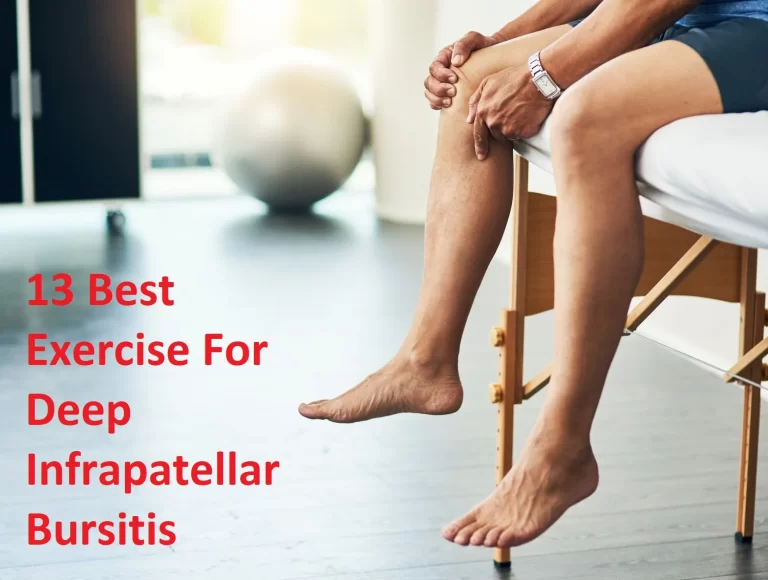
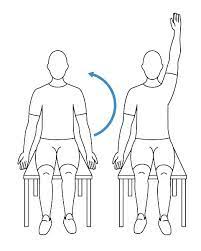
2 Comments